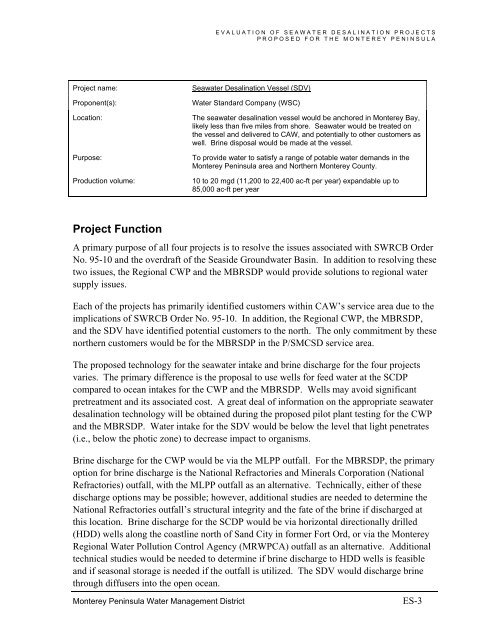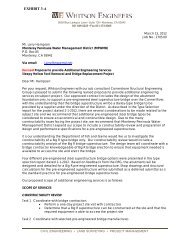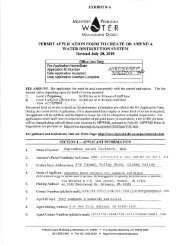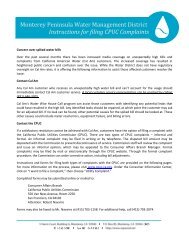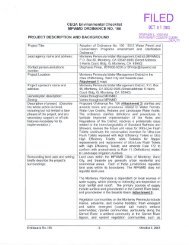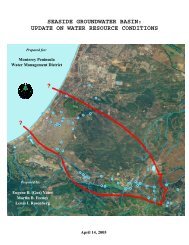FINAL REPORT Evaluation of Seawater Desalination Projects ...
FINAL REPORT Evaluation of Seawater Desalination Projects ...
FINAL REPORT Evaluation of Seawater Desalination Projects ...
Create successful ePaper yourself
Turn your PDF publications into a flip-book with our unique Google optimized e-Paper software.
EVALUATION OF SEAWATER DESALINATION PROJECTS<br />
PROPOSED FOR THE MONTEREY PENINSULA<br />
Project name:<br />
Proponent(s):<br />
Location:<br />
Purpose:<br />
Production volume:<br />
<strong>Seawater</strong> <strong>Desalination</strong> Vessel (SDV)<br />
Water Standard Company (WSC)<br />
The seawater desalination vessel would be anchored in Monterey Bay,<br />
likely less than five miles from shore. <strong>Seawater</strong> would be treated on<br />
the vessel and delivered to CAW, and potentially to other customers as<br />
well. Brine disposal would be made at the vessel.<br />
To provide water to satisfy a range <strong>of</strong> potable water demands in the<br />
Monterey Peninsula area and Northern Monterey County.<br />
10 to 20 mgd (11,200 to 22,400 ac-ft per year) expandable up to<br />
85,000 ac-ft per year<br />
Project Function<br />
A primary purpose <strong>of</strong> all four projects is to resolve the issues associated with SWRCB Order<br />
No. 95-10 and the overdraft <strong>of</strong> the Seaside Groundwater Basin. In addition to resolving these<br />
two issues, the Regional CWP and the MBRSDP would provide solutions to regional water<br />
supply issues.<br />
Each <strong>of</strong> the projects has primarily identified customers within CAW’s service area due to the<br />
implications <strong>of</strong> SWRCB Order No. 95-10. In addition, the Regional CWP, the MBRSDP,<br />
and the SDV have identified potential customers to the north. The only commitment by these<br />
northern customers would be for the MBRSDP in the P/SMCSD service area.<br />
The proposed technology for the seawater intake and brine discharge for the four projects<br />
varies. The primary difference is the proposal to use wells for feed water at the SCDP<br />
compared to ocean intakes for the CWP and the MBRSDP. Wells may avoid significant<br />
pretreatment and its associated cost. A great deal <strong>of</strong> information on the appropriate seawater<br />
desalination technology will be obtained during the proposed pilot plant testing for the CWP<br />
and the MBRSDP. Water intake for the SDV would be below the level that light penetrates<br />
(i.e., below the photic zone) to decrease impact to organisms.<br />
Brine discharge for the CWP would be via the MLPP outfall. For the MBRSDP, the primary<br />
option for brine discharge is the National Refractories and Minerals Corporation (National<br />
Refractories) outfall, with the MLPP outfall as an alternative. Technically, either <strong>of</strong> these<br />
discharge options may be possible; however, additional studies are needed to determine the<br />
National Refractories outfall’s structural integrity and the fate <strong>of</strong> the brine if discharged at<br />
this location. Brine discharge for the SCDP would be via horizontal directionally drilled<br />
(HDD) wells along the coastline north <strong>of</strong> Sand City in former Fort Ord, or via the Monterey<br />
Regional Water Pollution Control Agency (MRWPCA) outfall as an alternative. Additional<br />
technical studies would be needed to determine if brine discharge to HDD wells is feasible<br />
and if seasonal storage is needed if the outfall is utilized. The SDV would discharge brine<br />
through diffusers into the open ocean.<br />
Monterey Peninsula Water Management District<br />
ES-3


